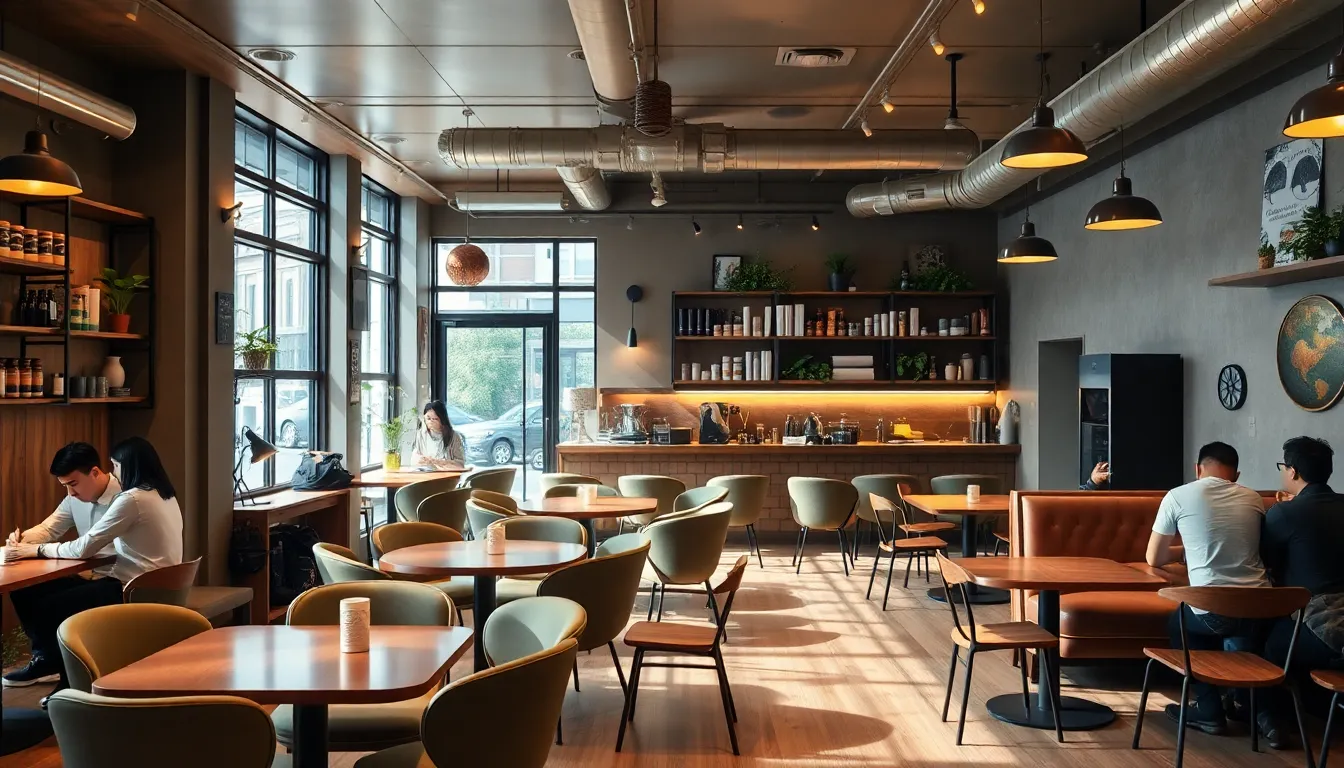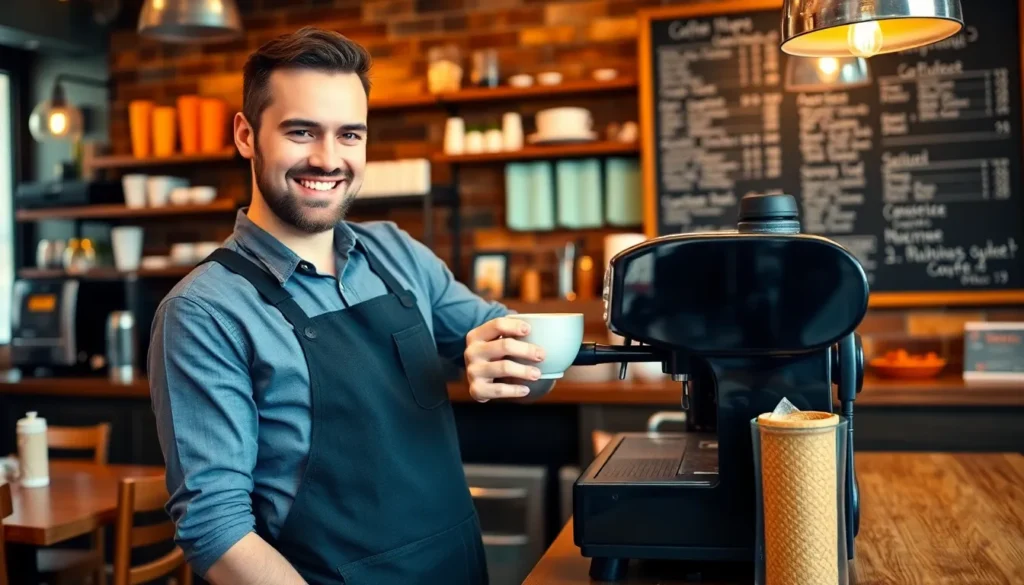In today’s fast-paced world, coffee shops have become more than just a place to grab a quick caffeine fix. They serve as social hubs where people connect, work, and unwind. The design of these spaces plays a crucial role in enhancing the overall experience, making it essential for owners and designers to consider aesthetics, functionality, and ambiance.
From cozy corners that invite relaxation to open layouts that foster collaboration, effective coffee shop design can significantly impact customer satisfaction and retention. Understanding the nuances of layout, lighting, and decor is vital for creating an inviting atmosphere that resonates with patrons. As coffee culture continues to evolve, so too does the importance of thoughtful design in crafting memorable experiences.
Table of Contents
ToggleImportance Of Coffee Shop Design
Coffee shop design plays a critical role in shaping customer experience and satisfaction. Design elements influence how patrons perceive the space, encouraging them to stay longer and visit frequently.
Aesthetics
Aesthetics provide the first impression. Unique decor, color schemes, and artwork create an inviting atmosphere, attracting customers. For example, a modern minimalist design may appeal to younger demographics while a cozy vintage theme might attract a more diverse clientele.
Functionality
Functionality supports customer needs. Efficient layouts facilitate movement and interactions, allowing for moments of connection. Strategic placement of furniture and equipment can improve workflow for baristas, enhancing service quality and customer satisfaction.
Ambiance
Ambiance, driven by lighting and sound, enhances the overall environment. Natural light boosts mood, while appropriate music fosters a relaxed setting. Creating a balanced ambiance encourages socialization and productivity.
Customer Retention
Effective design contributes to customer retention. Comfort and visual appeal result in longer visits, increasing the likelihood of repeat business. Comfortable seating and free Wi-Fi attract students and freelancers, reinforcing the coffee shop’s role as a community hub.
Brand Identity
Design reflects brand identity. Consistent themes and styles establish recognition. Organizing space to communicate core values fosters a connection with customers. For instance, eco-friendly cafes might highlight sustainability through design choices, attracting environmentally conscious consumers.
Coffee shop design is integral to the customer experience, influencing perceptions and interactions. Prioritizing thoughtful design elements can elevate a coffee shop from a simple service provider to a cherished community space.
Key Elements Of Effective Coffee Shop Design

Coffee shop design hinges on several key elements that significantly enhance customer experience. These components — layout, ambiance, and furniture — work in concert to create inviting and functional spaces.
Layout And Flow
Layout and flow determine how customers navigate the coffee shop. Efficient layouts include clearly defined pathways, allowing easy access to ordering counters, seating areas, and restrooms. Strategic placement of furniture encourages social interaction while maintaining personal space. Zoning distinct areas for work, relaxation, and conversations enhances usability. A well-planned flow minimizes wait times, enhancing overall satisfaction.
Ambiance And Atmosphere
Ambiance and atmosphere shape customer perceptions and experiences. Effective lighting establishes mood, with warm tones fostering comfort and bright lights promoting alertness. Soundscapes also play a role; soft background music encourages conversation, while silence supports focused work. The use of scents, such as freshly brewed coffee, triggers emotional responses that enhance the overall experience. Combining these elements creates an inviting environment, attracting repeat visits.
Furniture And Fixtures
Furniture and fixtures significantly influence comfort and usability. Selecting ergonomic seating ensures patrons can stay longer without discomfort. Tables should accommodate various group sizes, ranging from small, intimate settings to large community tables. Fixtures, including shelving and display cases, enhance both aesthetics and functionality, showcasing products while reinforcing brand identity. Consistent design themes across furniture and fixtures contribute to a cohesive visual experience, helping establish the coffee shop’s unique character.
Trends In Coffee Shop Design
Modern coffee shop design embraces innovative trends that enhance aesthetics, functionality, and customer experience. Key movements in this space include sustainability and technology integration, which shape how coffee shops operate and engage customers.
Sustainability And Eco-Friendly Practices
Sustainability becomes a cornerstone of coffee shop design. Shops prioritize eco-friendly materials, utilizing reclaimed wood, recycled metals, and non-toxic paints. Many coffee shops incorporate green practices, such as composting, energy-efficient appliances, and water-saving equipment, minimizing their environmental impact. Incorporating plants, green walls, and natural light enhances the ambiance while promoting a connection to nature. Offering reusable cup discounts encourages customers to adopt sustainable habits, fostering a community-minded atmosphere.
Technology Integration
Technology integration revolutionizes coffee shop design. Shops now feature mobile ordering systems, contactless payments, and Wi-Fi access to enhance customer convenience. Smart furniture, such as charging stations embedded in tables, supports the needs of remote workers. Digital menu boards provide flexibility, enabling quick updates on offerings. Enhancing the customer experience through interactive kiosks or apps streamlines service and allows for personalized recommendations, increasing customer loyalty and satisfaction.
Case Studies Of Successful Coffee Shops
Successful coffee shops often showcase innovative design through unique concepts and user experience focus. These elements highlight the significance of thoughtful planning in creating inviting spaces.
Unique Concepts And Themes
Unique concepts and themes set successful coffee shops apart. For instance:
- Third Place Concept: Shops like Starbucks embrace the “third place” model, serving as a comfortable alternative to home and work. This approach fosters community connections.
- Local Culture Integration: Blue Bottle Coffee in Oakland draws inspiration from the local art scene. Custom murals and decor enhance the regional identity while attracting both locals and tourists.
- Interactive Spaces: The Coffee Collective in Copenhagen features roasting areas visible to customers. This transparency engages patrons, creating an immersive experience that educates about coffee sourcing and brewing.
These shops demonstrate how distinctive themes resonate with customers, making them more than just a place to grab coffee.
User Experience Focus
User experience remains central to successful coffee shop designs. Key elements include:
- Comfortable Seating Arrangements: Shops like Café Grumpy in Brooklyn offer a variety of seating options. Cozy corners encourage relaxation while communal tables facilitate social interaction.
- Intuitive Navigation: Blue Bottle Coffee’s straightforward layouts ensure customers easily find their way and place orders, enhancing overall efficiency.
- Ambiance and Sound: The quiet, warm atmosphere of Intelligentsia Coffee provides a conducive environment for conversation and productivity, attracting remote workers and casual visitors alike.
By prioritizing user experience, these coffee shops create environments that invite customers to stay longer and return frequently.
The design of a coffee shop plays a pivotal role in shaping customer experiences and fostering community connections. By prioritizing aesthetics functionality and ambiance coffee shops can create inviting spaces that resonate with patrons. Thoughtful design not only enhances customer satisfaction but also reflects brand identity and values.
As trends evolve incorporating sustainability and technology will further enrich the coffee shop experience. Embracing these elements not only attracts diverse clientele but also builds loyalty. Ultimately a well-designed coffee shop transcends its primary purpose becoming a cherished gathering place that encourages connection creativity and relaxation.









